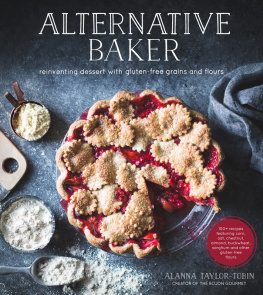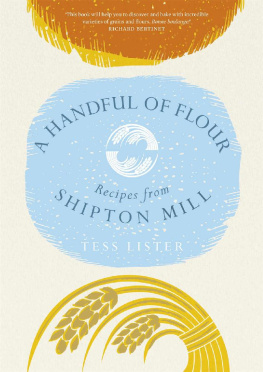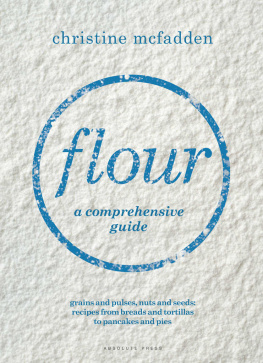
ALTERNATIVE BAKER
reinventing dessert with gluten-free grains and flours
WRITTEN AND PHOTOGRAPHED BY
ALANNA TAYLOR-TOBIN
CREATOR OF THE BOJON GOURMET

The author and publisher have provided this e-book to you for your personal use only. You may not make this e-book publicly available in any way. Copyright infringement is against the law. If you believe the copy of this e-book you are reading infringes on the authors copyright, please notify the publisher at: http://us.macmillanusa.com/piracy.
TO MY GRANDMOTHERS,
ANNE AND BUBBA, FOR ALWAYS
SHARING THE BEST COOKIES

At a birthday party the other day, my sweetie Jay and I were offered a chocolate cupcake from a local bakery. I had been testing recipes for this book for seven months and we were up to our ears in unconscionable amounts of baked goods that all boasted alternative grains and seasonal fruits and vegetables. Not wishing to be rude, Jay took a bite, and frowned. Its bland, he whispered. I tasted the cupcake, expecting something super sweet and flat, and was pleasantly surprised. The cake was well seasoned, not too sweet and quite chocolaty, with enough salt to counter the sugar. The frosting was creamy and smooth, the cake rich and moist. What was missing? Before we left for the party, Id baked a batch of the Buckwheat Pear Galettes with and Jay and I had shared one, still warm from the oven. The charcoal-hued crust shattered against tender pears coated in a nap of salty caramel, warm buckwheat exuding notes of chocolate and spice, earth and toasted nuts. It was then that I realized: our palates had become accustomed to alternative grains.
Baking with alternative grains opened up a whole new feast of flavors, textures and colors that I never knew existed. Culinary pioneers Kim Boyce and Alice Medrich have shown us that these flours arent just desirable for their nutritional value, but also for the aesthetic pleasurestouch, taste and smellthat they bring to the kitchen. Its been a delight to see the look on friends faces when they bite into a for the first time; their eyes widen, corners of the lips turn upward and a look of pure surprise crosses their faces. What is this new flavor Im tasting? they ask.
Buckwheat flour sings of toasted hazelnuts mingling with cocoa and cinnamon. Teff flour tastes of malted milk and chocolate, mesquite flour of baked earth and chestnut flour is wildly sweet and rich. Sorghum and millet are nutty and grassy; amaranth is potently vegetal and almost herbaceous. Coconut flour is sweet with notes of the tropics, and almond flour has a delicate nuttiness. Replace the all-purpose flour in gingersnaps with sweet rice and mesquite flours, add teff flour to cobbler biscuits or whip up some scones made with oat and amaranth floursall of a sudden what was once rather ordinary when made with everyday white flour becomes extraordinary.
In my kitchen, flavor comes first, but there are other benefits to playing with alternative grains and flours, too. Each has its own fragrance, color, history and nutritional profile. I always look forward to opening a jar of teff flour, whose malty smell takes me back to kindergarten and glasses of malted chocolate milk at recess. The lactic, whole-grain scent of oat flour reminds me of baking cookies on a rainy day. When I pull out my bag of mesquite flour with its reddish tan hue and scent of baked earth, Im instantly transported to the red, rocky deserts of Arizona and New Mexico, where I traveled as a teen. The sunny yellow of corn flour never fails to cheer me, and I could gaze at buckwheat flour, with its heathered gray hue and charcoal flecks, for hours. Its a sensory experience.
Once Id grown to love these flours and developed my own associations with them, researching their histories was even more fascinating. For example, protein-rich amaranth is strongly linked to the Aztec empire, where it accounted for 80 percent of diets, was used in religious rites and when popped and mixed with honey, embodied statues of the Aztec gods. Mesquite flour, on the other hand, nourished desert-dwellers native to North America, and has the unique ability to slow the metabolization of food and stabilize blood sugar levels. Teff, the worlds tiniest grain, hails from the isolated Ethiopian highlands and is the only grain to contain significant levels of vitamin C. And chestnut flour, now considered the upper echelon of alternative flours with a price tag to match, was pooh-poohed as peasant food for centuries.
), but balancing them with sticky ingredientssweet white rice flour, tapioca, ground chia seeds and eggs, to name a fewallows their good qualities to shine. Most of my recipes now come together with a minimum of fuss, and with tastes and textures that surpass their refined wheat counterparts, piquing the palate of the most sensitive celiac to the most ardent wheat-eater.
So it is with this new palette of flavors, textures and histories that we make new of what was once old. Im delighted to share this collection of recipes based on alternative grains and flours and punctuated by all manner of delicious ingredients, from peak-of-season fruit to sweeteners to chocolate and spirits.
So lets get baking. Lets reinvent dessert.


Some of these recipes can seem intimidating at first, particularly if you are new to baking, to alternative flours or to working with seasonal ingredients. Here are some suggestions on how to approach these recipes without hating life. (Read more about alternative grains and flours on .)
FLOUR CHILD
If youre just beginning to dabble in GF baking (or baking at all) and are looking to stock your pantry with a few alternative grains, start with recipes that use just two or three flours.
These flours are easy to find and even easier to love with their mild flavors and multipurpose uses:
Almond flour
Millet flour
GF oat flour and old-fashioned rolled oats
Polenta/corn grits, cornmeal and corn flour
Sweet white rice flour (a.k.a. glutinous rice flour; NOT regular white rice flour)
Try these easy-peasy recipes:
FLOUR POWER
If you have some experience with gluten-free, alternative flour baking and wish to expand your repertoire, try these slightly less common flours:
Teff flour
Buckwheat flour
Coconut flour
Sorghum flour
And the sometimes fussier recipes that use them:
GRAINIAC
If youre an adventurous baker who wants ALL the flours, look for:
Mesquite flour
Chestnut flour
Amaranth flour
And try these recipes:
(and the recipes that use them)
Any of the pie or pandowdy recipes; the dough takes some getting used to but produces stunning results












